The Moto G is a rare beast: a budget-priced phone from one of the most respected players in the mobile industry. Motorola doesn’t just stamp their name on any old handset, and it’s more apparent than ever with the 2014 refresh to the company’s best selling smartphone of all time. While the Moto G makes some sacrifices to reach its $179 retail price, it more than makes up for them with its combination of pure Android and attractive design.
Build & Design
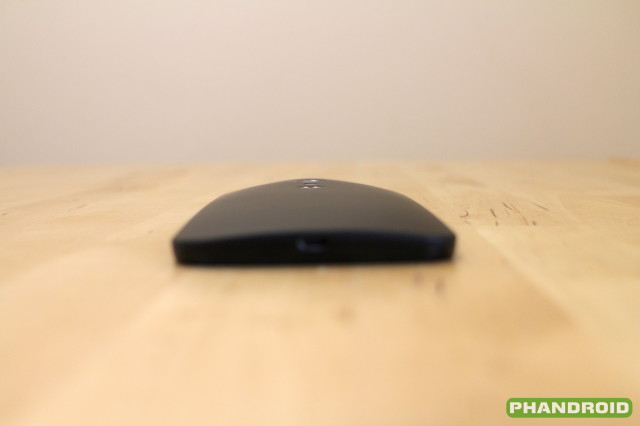
Little has changed year-over-year in the design of the Moto G. At a glance, it features the same rounded edges and curved back that imbue the handset with a subtle classiness you might expect from a phone twice its price. The design language is borrowed from the Moto X (both the 2013 and 2014 iterations), though the build differs. Where the second generation Moto X introduces aluminum construction and accents, the Moto G retains its plastic frame. Still, the phone feels solid in a way that we’ve come to expect from Motorola device, regardless of the materials used.
The Moto G has increased in size and weight ever so slightly. The phone is a hair over 4mm wider at 70.7mm and grows by 11mm in height to 141.5mm. Weight sees a barely noticeable increase from 143g to 149g. What hasn’t changed is the handset’s thickness, which remains 6.0mm at its thinnest edge increasing to 11mm at the peak of its curved back.
That curve, by the way, serves a dual purpose. It not only give Moto some flashier thickness figures to throw around, but it also creates an inviting feeling to the hand. It adds an ergonomic shape that keeps the Moto G from feeling big or unwieldy. Bezel snobs will also be happy to know that Motorola has once again done their best to increase the overall screen-to-body-size ratio.
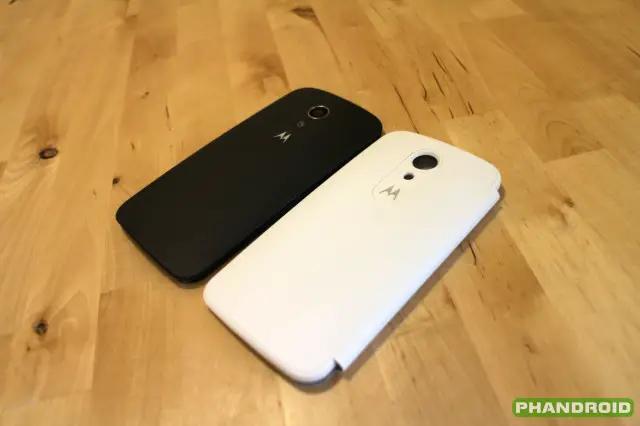
Buyers are given two finish options when buying the Moto G (white or black), but Motorola has extended a touch of the personalization available for their pricier Moto X to its cheaper counterpart. This includes a replaceable back that can be swapped out for a variety of colored Motorola Shells. New to the 2014 edition are Motorola Flip Shells, which provide a folio-style screen cover for added protection.
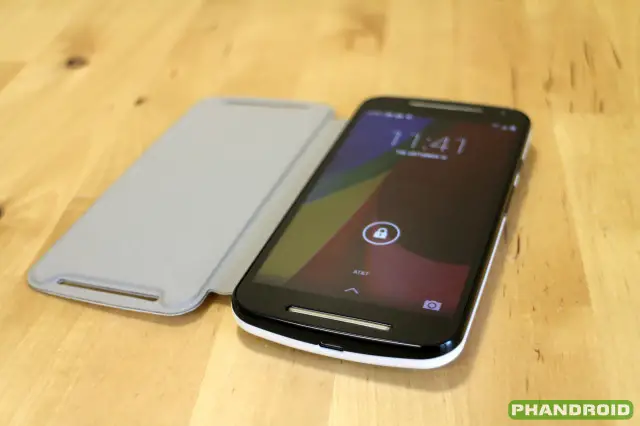
Display
As for that screen? The Moto G’s display has increased in size — quite literally the biggest change from first generation devices — but not resolution. The result is a display with a lower pixel density but more real estate for enjoying apps, games, movies, and more. At 5 inches (half an inch larger than the previous models’s 4.5-inch display) and 1280×720 pixels, the Moto G lacks the flashy resolution other devices of a similar size employ, but it’s hard to argue with what you get for the price (a recurring theme when reviewing the handset).
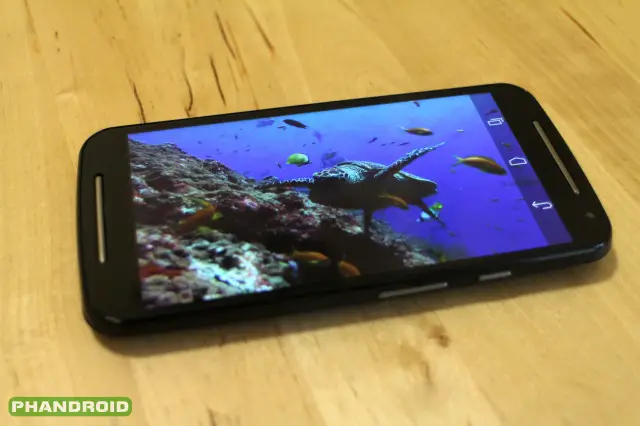
While top-tier Android devices move into the realm of Quad HD, let’s not forget that the Moto G’s resolution is on par with that of Apple’s iPhone 6, a phone with a top-of-the-line price and marketed as such. 720p might seem like old hat for Android users. It might even seem like a cop out. It still looks sharp and clear, however, and leaves little room for complaint.
Hardware
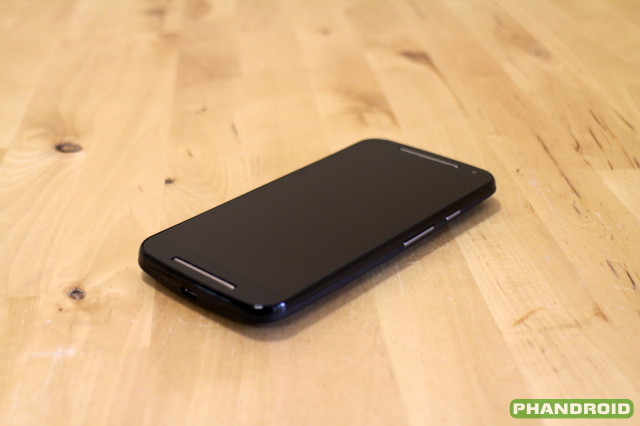
As a low-priced handset aiming for a premium experience, the Moto G’s hardware is a bit of a mixed bag. Whereas Motorola went bigger with the display, the Snapdragon 400 processor within the handset remains identical to the previous generation. This is almost unheard of in the world of Android devices where we might at least expect a bump in clock speed or other performance factors. Instead we see the same 1.2GHz quad-core processor and Adreno 305 GPU as last year.
That’s not necessarily a knock on performance. The Snapdragon 400 gets the job done efficiently and effectively (a stock build of Android 4.4 helps), but as the latest handsets move toward Snapdragon 801 and 805 platforms, it would seem logical to at least see a jump to Snapdragon 600. We digress, though.
Motorola instead chose to focus on feature-focused hardware updates for the Moto G, the big two being the addition of front-facing stereo speakers and a MicroSD card slot. The latter allows users to expand on the 8GB or 16GB of internal storage the Moto G carries with up to an additional 32GB of removable storage.
Some potential buyers will be disappointed to learn that Motorola did not introduce an LTE-ready Moto G out of the gate, nor is the phone compatible with CDMA networks like Verizon and Sprint. With the original Moto G, Motorola eventually released versions of the device that addressed both of these shortcomings. We might expect them to do the same here.
As is, the handset is outfitted with GSM radios capable of HSPA+ speeds on AT&T and T-Mobile’s network. Globally, a dual SIM version of the device is compatible with a broad range of GSM networks and service providers.
Software
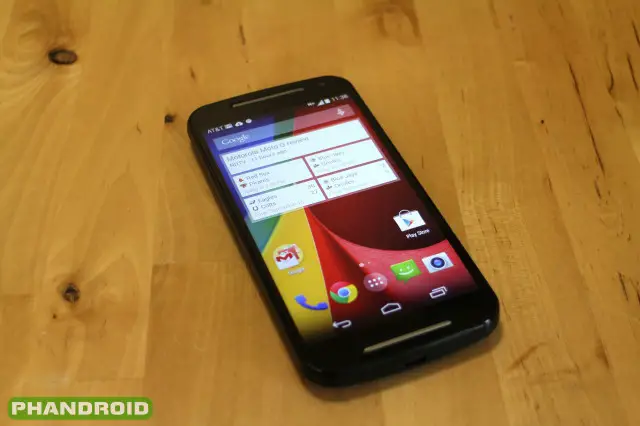
One aspect of the Moto G Android enthusiasts are sure to find appealing is the decision to go with a “pure” infall of Google’s KitKat operating system. Officially Android 4.4.4 out of the box, the Moto G benefits from the same software capabilities available to owners of higher-end Nexus and Google Play Edition handsets.
Motorola has included a few helpful software benefits, however, for Moto G users. These include Motorola Migrate, a service that makes transitioning from anything from a feature phone to an iPhone extremely easy. Just a few taps will transfer contacts, photos, and other stored data. Motorola Assist puts a filter on incoming calls and alerts when you are sleeping or in an important meeting. Motorola Alert helps notify friends and family of your whereabouts, whether you are arranging a meet up or experiencing an emergency.
One awesome feature we don’t see enough in smartphones is the inclusion of FM radio software (to go along with a built-in FM tuner). Using wired headphones as an antenna, the Moto G can pick up and playback local FM feeds without the need for a WiFi or cellular connection. A little more old school than Spotify, but nifty nonetheless.
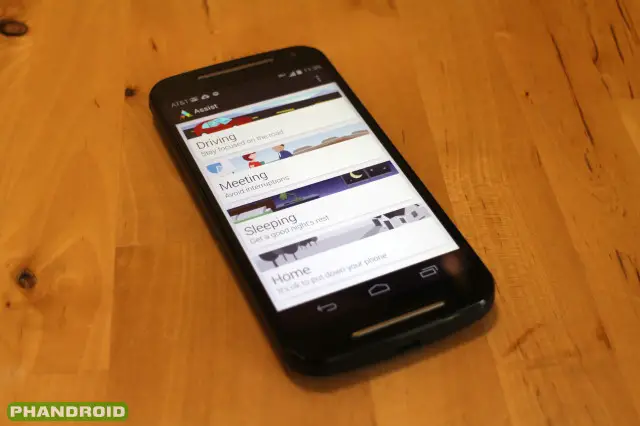
Another software/hardware combination feature that comes in handy is Trusted Devices, which allows the Moto G to operate without password protection provided it is in range of a “trusted” Bluetooth device. This could be a headset, a computer, or even a Bluetooth speaker. When the Moto G is paired to the device, waking the phone skips the lock screen and gets you right into the action.
Beyond these additions, the Moto G has access to Google services like Gmail, Maps, Hangouts, Chrome, and more. With a stock Android implementation, there is no confusion between these apps and competing services that manufacturers and carriers typically include. It also enables the handset to take full advantage of Google Now’s predictive info cards and helpful voice actions.
While on the subject of stock Android, Motorola is guaranteeing at least one version upgrade beyond what comes installed on the phone. This means when Google has Android L ready to ship, Moto G owners will be on the short list to receive it. And while they are only promising one update, we wouldn’t be surprised to see Motorola support the phone for at least a few more. It really doesn’t get much better than what Motorola is doing here.
Camera
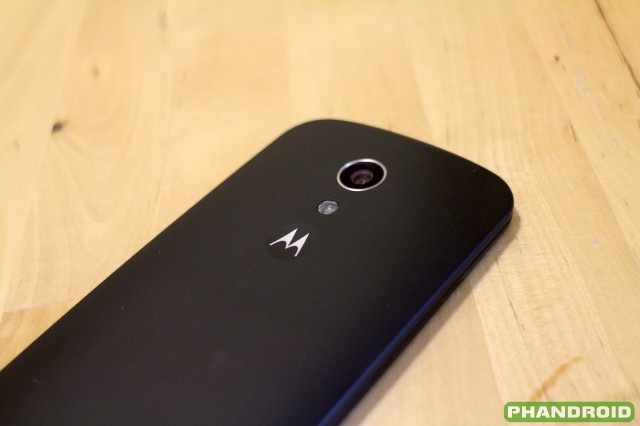
The Moto G sees an improved 8MP camera as part of its updates as well as the introduction of a few software features (and one more hardware goody). The camera itself has improved with an f2.0 aperture and also includes LED flash and 4X digital zoom. Shooting modes include slow motion video, burst shot, HDR, and panorama.
Users have options when it comes to actually capturing a photo. By default, tapping the screen will focus the image on the area of interest. A flip of a setting enables One-Tap Capture, which will focus and snap a shot at the touch of a finger. The Moto G can also take advantage of a hardware shutter button (a secondary function of the phone’s volume rocker).
Image quality is solid, and 720p video is smooth. We’ve seen better on other smartphones, but the full package is impressive for a device of this class.
Battery
Motorola promises “all day battery life” for the Moto G, and the phone’s 2070mAh battery certainly has the qualifications on paper. This is where a sub-1080p display, Snapdragon 400 processor, and a lack of LTE come in handy, as their power draw is theoretically reduced.
The battery itself is the same size as the power cell of the first generation handset, and it did well enough in our testing. It is reasonable to expect the phone to get similar performance in this spec compared to last year’s model, but mileage will vary by usage. “All day battery life” really depends on how you define “all day.” A single charge will certainly get you from sun up to sun down, but cracking the 24-hour mark might be a rare occurrence.
The Bottom Line
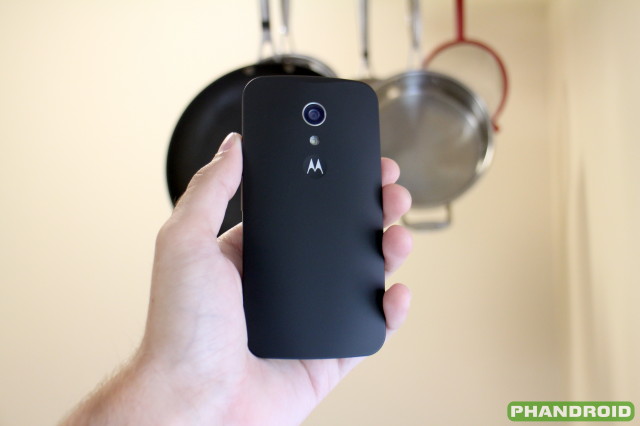
It would be easy to recommend the Moto G as the phone to buy for those on a budget. Saying that, however, sells the handset a little short. The Moto G is a perfectly respectable phone to buy for almost anyone who was already planning on spending $200 up front for a phone with a required two-year contract. In fact, at $180 said shopper will save money and be free of any sort of carrier obligations or restrictions on when he or she can upgrade their phone.
The Moto G most certainly is not a phone designed for folks seeking a powerhouse along the lines of the Galaxy S5 or LG G3, but for users who can avoid falling prey to the hype of octa-core processors and Quad HD displays, it does everything you need and more. The decision to stick with a stock install of Android 4.4 adds even more appeal to the Moto G, making it a great choice for fans of the pure “Google Experience.”
Wrap the solid specs and powerful software in a quality build that not only looks great but offers room for personalization via its replaceable back cover and the Moto G is even harder to deny. Did we mention all of this comes at a price of only $180?
The Good
- Stock Android 4.4 with guaranteed upgrade
- Solid, attractive build with customizable back
- $179 off-contract
The Bad
- No LTE version or CDMA support
- No upgrade from first generation’s Snapdragon 400 SoC
The Bottom Line: 4/5

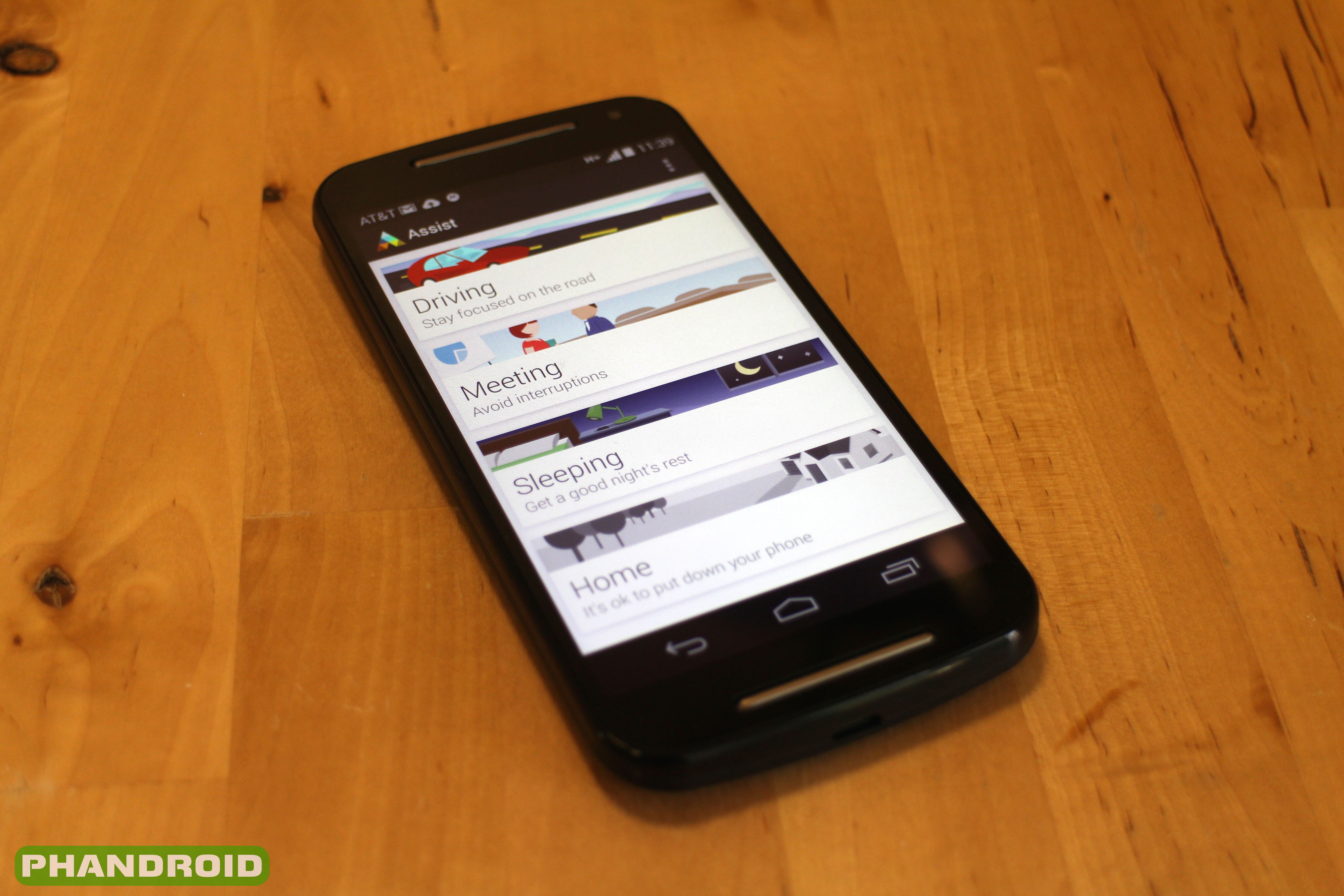
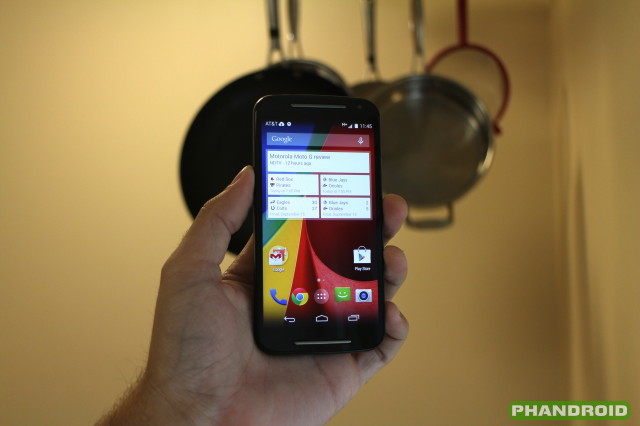







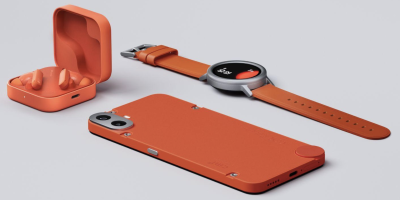






I don’t see why they couldn’t have included LTE in this. That is the one thing holding me back from buying this or recommending it!
Be patient. There’ll probably be an LTE Verizon later. And they excluded the LTE radio to get the price lower for other markets where LTE still isn’t as mature as here (or not present at all).
no LTE = fail
a year ago i wouldn’t say that, but now…
Hspa+ is comparable to LTE, and its not capped
The Bad = 5 inch screen
Do you want it bigger, or smaller? 4.5 (last year’s model) is about right for me, and some people think even that is too big. The other bad is that it seems 16GB is no longer an option in the US. They presumably think adding an SD slot takes care of that, but it’s nice having plenty of space in the actual /data partition.
32 gb should be the starting storage size for all phones that have 1080p, and 4.5 inches is too big, 4 inches is the perfect phone size though.
32gb is understandable for top end phones, you forget this is a budget phone.
True, but i’m just talking about high end phones in general. Obviously a “budget friendly” phone would not have the starting storage option of 32gb
No, it really shouldn’t. 16 is just fine.
Not it you have a bunch of games and apps on your phone.
For those people, 32 should be an option. Some people don’t have a bunch of games and apps so 16 works just fine. Therefore, 32 shouldn’t be the starting storage size, 16 is just fine.
I meant for high end phones, not this one.
And I meant for any phone. I’ve only bought flagship phones and I have no need whatsoever for 32GB. It should be an option for people who want it, but not the starting point because many people don’t want or need that much. Even people who buy high end phones.
4 inch phones? Do you have an iPhone in your pocket? Those numbers no longer apply in this world, average is 4.7-5 inch.
But why does it have to be? Why can’t we make processors even smaller, but faster? Or batteries smaller, but hold more charge? Why does everything have to be so damn big?
They want us to buy their accessories that are small (in ear, Glass, Wear, etc.)
Processors are smaller and faster, just like all internal components.
It’s the transgressions of tech, we went from huge mobile phones to tiny ones and now back up in size.
They should have upgraded the battery.
The digitizer and screen broke on My nexus 4 broke last week so I ordered one of these to hold me over for a few weeks. It arrived yesterday and I am surprised at how solid and snappy this phone is. I have had many android devices both low and high end for development purposes over the past 5 years and this is the best bang for the buck device I have ever used. If you need an inexpensive android phone don’t waste your time with any of the other budget devices as they will just frustrate and annoy you ;).
Even with all of my apps and settings loaded from my nexus 4 this thing is pretty quick. Some games aren’t as smooth as they could be (i tried asphalt 8 and crazy taxi) but they are still more than playable.
PPI? Would this perform better than GS3? (Snapdragon S4 Pro @ 1.5 GHz)
Maybe… considering moto g has pure android it might run faster
Everything performs better than anything with touchwiz
I’ve had the original Moto G since it first came out and I love it. It’s the best phone I’ve ever had (all the others have been by Samsung), but I am not a power user. I’ve never had a problem with it and for the money, it has been the best deal around. I’d like the new one, but there is no reason to get rid of this one….until the battery dies ;(
processor and resolution fail all is ok
My wife and I both had the 1st gen, and we were both very impressed. I have a thing for “bells and whistles” though, so I bought the first gen moto x as well. In all honesty, with the same uses, the moto g’s battery usually lasted 2 to 3 hours longer than my moto x, but I stuck with the x anyway. My wife on the other hand has always preferred basic phones, so she stuck with her g. When the 2nd gen moto g hit the Motorola website, it was a no -brainer for me to get it for my wife, and she’s had it for 3 days now and loves it.
Where is the 16GB 2nd generation Moto G available? It looks to me like 8GB is the only option.
Can’t figure out why I would get this over the Moto G LTE. It’s the same phone as last year but with a bigger screen…WTF Motorola?